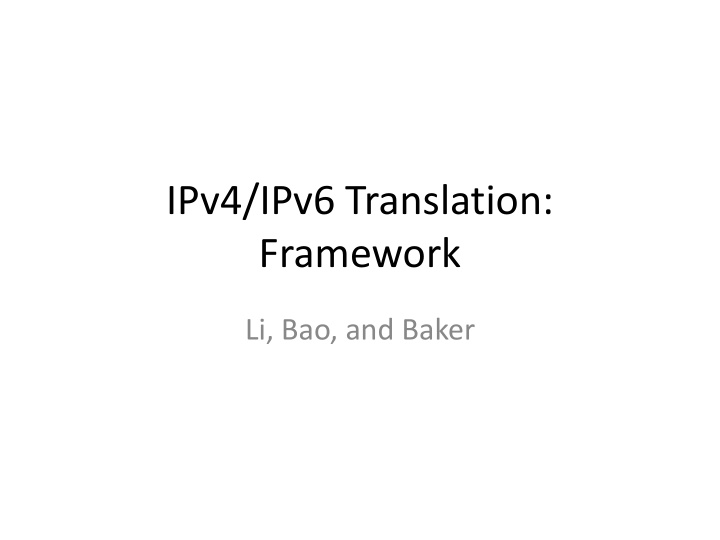



IPv4/IPv6 Translation: Framework Li, Bao, and Baker
Outcome from the Montreal Interim • Basically, merging NAT64 and IVI to produce a common translation technology – Not to exclude other documents, but these form the basis • Described in at least four documents: – Framework • draft-baker-behave-v4v6-framework – SIIT Update – basic translation behavior • draft-baker-behave-v4v6-translation – Extensions for stateful translation • draft-bagnulo-behave-nat64 – DNS Translation gateway • draft-bagnulo-behave-dns64 – Possible future documents • FTP ALG etc
Scenario Xlate IPv4-only IPv6-only DNS IPv4 packets IPv6 packets • The IPv4 packets arrived in the IP/ICMP translator will be translated to IPv6 packets. – The translator translates the packet headers from IPv4 to IPv6 and translate the addresses in those headers from IPv4 addresses to IPv6 addresses. • The IPv6 packets arrived in the IP/ICMP translator will be translated to IPv4 packets. – The translator translates the packet headers from IPv6 to IPv4 and translate the addresses in those headers from IPv6 addresses to IPv4 addresses. 3
Terminology (1) • State – Refers to dynamic per-flow or per-host state • Stateless translation – The translation information is carried in the address itself, permitting both IPv4->IPv6 and IPv6->IPv4 sessions establishment. • Stateful translation – Translation state is maintained between IPv4 address/port pairs and IPv6 address/port pairs, enabling IPv6 systems to open sessions with IPv4 systems. 4
Terminology (2) • IPv4-mapped IPv6 address – The IPv4-mapped IPv6 addresses are the IPv6 addresses which have unique relationship to specific IPv4 addresses. – This relationship is self described by embedding IPv4 address in the IPv6 address. • Unmapped IPv6 address – The unmapped IPv6 addresses are general IPv6 addresses. – There may exist relationship to the IPv4 addresses, but this relationship is maintained as the states (mapping table between IPv4 address/port and IPv6 address/port) in the translator. – The states are either manually configured or session initiated. 5
Terminology (3) • IPv4 address pool – In the stateful mode, a certain amount of IPv4 addresses are maintained in the translator as the IPv4 address pool. – In the stateless mode, there is no IPv4 address pool in the translator. A special block of IPv4 addresses are reserved, embedded in the IPv6 addresses and represented by the IPv6 end systems. 6
IPv4/IPv6 Translation: temporary tool to help coexistence/transition • IPv4 addresses – Embedded in an IPv6 prefix in the IPv6 domain – Stateless and stateful translation • Connectivity provided: – IPv4 <-> IPv4 IPv4 or IPv4+IPv6 – IPv6 <-> IPv6 Domain – 1:N IPv6 -> IPv4 (unmapped) – 1:1 IPv6 <-> IPv4 (mapped) DNS • Attributes: ALG – Enables services in both domains – Stateless translation works in IPv6 Domain multiple providers, multiple translators • Experience: – IVI 2 years in CERNET – NAT-PT/SIIT commercially deployed
The address format chosen • Basic format: – IPv4 address embedded in IPv6 address • Prefix: provided by the network administration – 0::0/3 format has routing issues with multiple translators and with multiple IPv4 domains – 0::0/3 format partially deprecated in RFC 4291 • Placement of IPv4 address: – Cook’s choice: IPv4 bit 0 in IPv6 bit 33..63 or 96 – Prefix64::/96 format appropriate for CPE and for stub IPv4 networks – Putting upper part of prefix in routing locator appropriate for ISP usage
ISP usage #1 • Carrier Grade NAT, if you will – Designed to facilitate carrier transition with customers in various phases of transition • Enables service: – IPv6 /48 or longer general prefix to customer – Equivalent of IPv4 /24 or longer to customer in IPv6 form for access by remote IPv4-only hosts with 1:1 stateless translation – Requires advertisement of /64 by edge network for IPv4-mapped IPv6 addresses – IPv6-only service with • remote IPv4 hosts accessing local mapped IPv6-only servers and • local IPv6 hosts accessing remote IPv4-only servers Prefix Host Identifier
ISP usage #2 (residential/SOHO/SMB) • Dual stack customers around IPv6-only network • /64..48 to customer results in IPv6-only Network Domain – One /64 translated to IPv4 Or host – 2 n -1 /64 IPv6 subnets – No IPv4-accessible servers IPv4 Address ISP provided /96 prefix IPv4+IPv6 LANs
Stub network usage: Access to legacy equipment • IPv6-only network, IPv4-only equipment (could be dual stack but network chooses not to) IPv6-only • /64 prefix to RFC 1918 space Network Domain or host with 1:1 stateless translation IPv4 Address Network-provided /96 prefix IPv4 LAN
Routing advertisements by translator Xlate IPv4-only IPv6-only DNS • In the IPv4 network – Translator advertises an IPv4 prefix for stateless translation in ISP#1 case – Translator advertises an IPv4 prefix for the stateful translation address pool – Attracts traffic destined for translation to IPv6 • In the IPv6 network – Translator advertises an IPv6 prefix for entire IPv4 address space – Attracts traffic destined for translation to IPv4 12
Usage of 1:n translation • Primarily to let IPv6-only hosts with general format addresses access IPv4-only servers/peers • IPv4 access to general IPv6 hosts excluded due to complexity
Usage of DNS translator • Client/Server and Peer/Peer – Enable IPv6 hosts with mapped addresses to be accessible to IPv4 clients/peers – Enable IPv4 hosts to be accessed by IPv6 clients/peers • Designed for simplicity and maintainability – Simplest case is static configuration of records – Capable of dynamic translation A<->AAAA – Capable of multiple DNS servers with predictable results and no state other than DNS caches
Recommend
More recommend